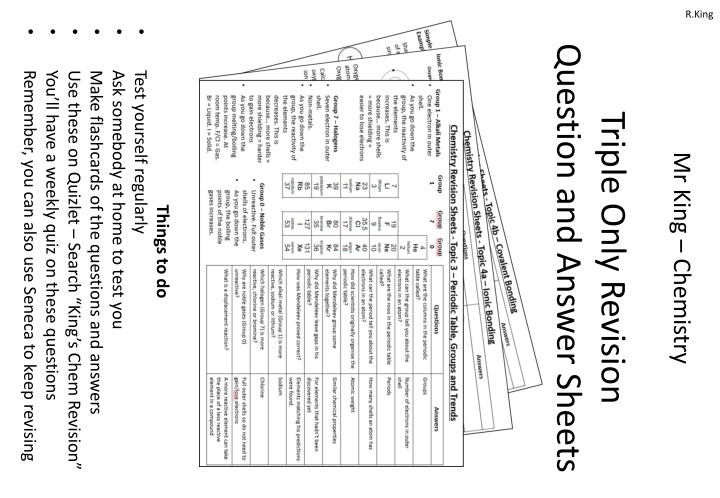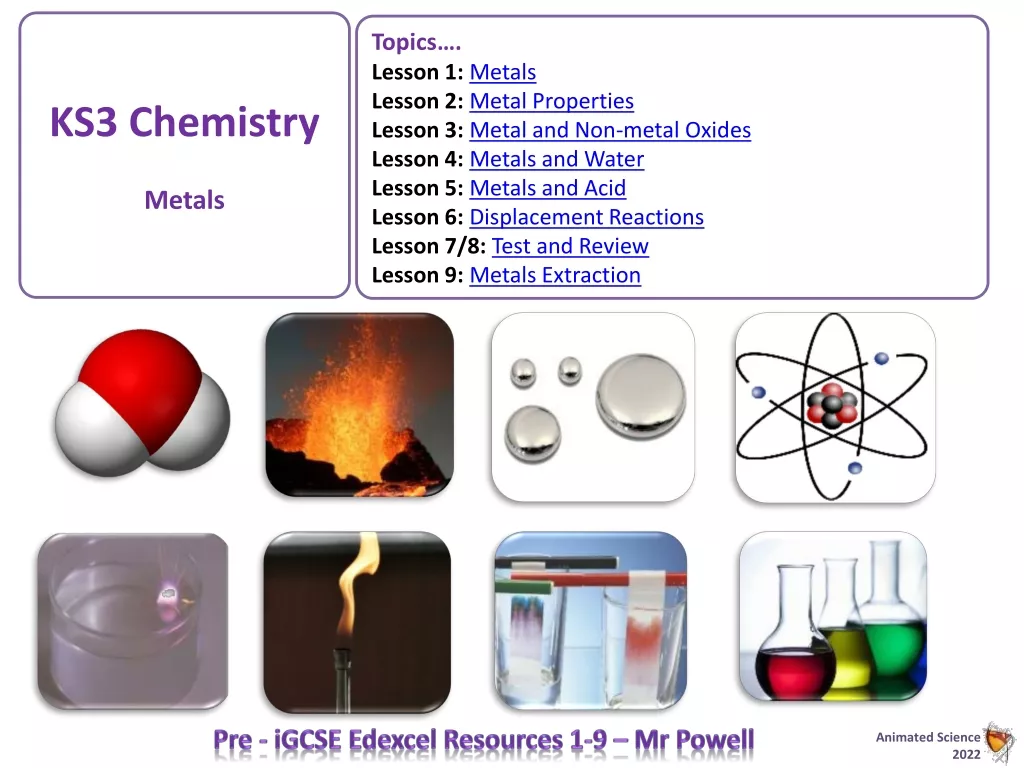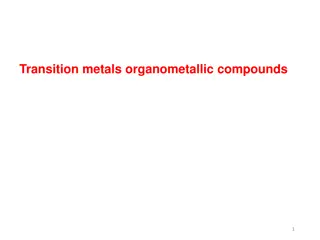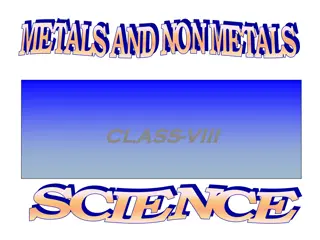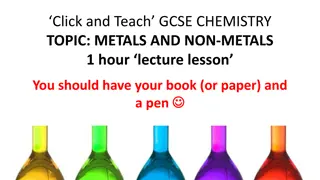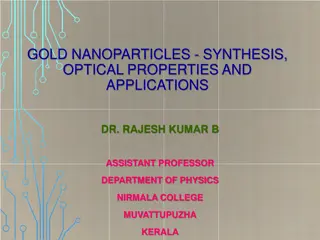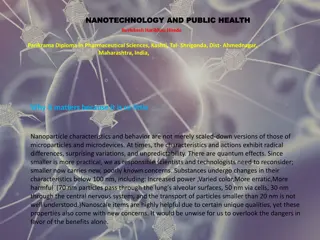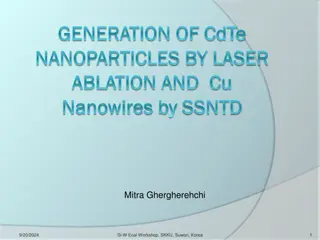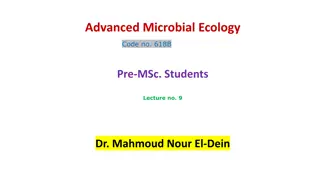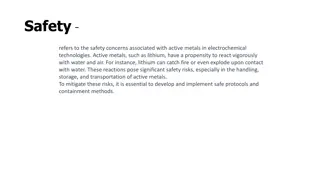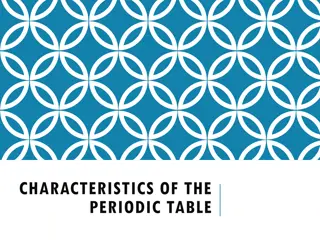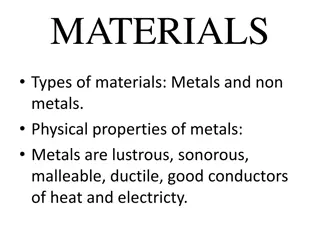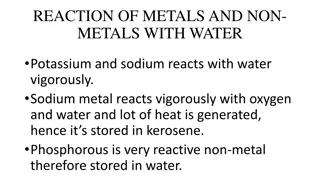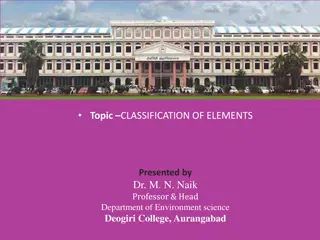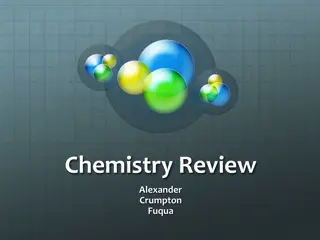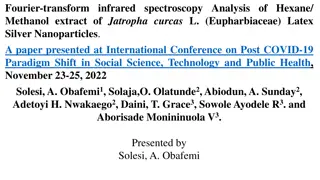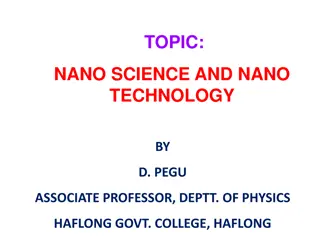R.King Chemistry Revision: Transition Metals and Nanoparticles
This content provides question and answer sheets for chemistry revision, focusing on Transition Metals and Nanoparticles. Topics covered include properties of transition metals, reactions with oxygen, nanoparticle sizes, surface area-to-volume ratio, and uses of nanoparticles. Utilize these resources for effective studying and preparation for quizzes.
Download Presentation

Please find below an Image/Link to download the presentation.
The content on the website is provided AS IS for your information and personal use only. It may not be sold, licensed, or shared on other websites without obtaining consent from the author.If you encounter any issues during the download, it is possible that the publisher has removed the file from their server.
You are allowed to download the files provided on this website for personal or commercial use, subject to the condition that they are used lawfully. All files are the property of their respective owners.
The content on the website is provided AS IS for your information and personal use only. It may not be sold, licensed, or shared on other websites without obtaining consent from the author.
E N D
Presentation Transcript
R.King Question and Answer Sheets Remember, you can also use Seneca to keep revising You ll have a weekly quiz on these questions Use these on Quizlet Search King s Chem Revision Make flashcards of the questions and answers Ask somebody at home to test you Test yourself regularly Triple Only Revision Mr King Chemistry Things to do
R.King Chemistry Revision Sheets Triple Topic 1 Transition Metals Transition Metals Questions Answers Given an example of a transition metal Cr, Mn, Fe, Co, Ni, Cu Conduct electricity, as solid/liquid Shiny, when freshly cut Give two properties of transition metals Transition Metals Transition metal or group 1 metal. Which has the highest melting point? Transition metal Transition metal or Group 1 metal. Which has the highest density? Transition metal Transition metal or Group 1 metal. Which is softer? Group 1 metal Transition Metals Group 1 Metals A metal has a melting point of 1890o C. Is it a transition metal or a group 1 metal? High melting/boiling points High density Hard React slowly with water and oxygen (or not at all) Form coloured compounds Form ions with different charges Low melting/boiling points Low density Soft React violently with water React quickly with oxygen Form white compounds Form ions with a single charges Transition metal high melting point A metal has a melting point of 98oC. Is it a transition metal or a group 1 metal? Group 1 metal low melting point Group 1 metals react quickly with oxygen. Describe the reactions of transition metals with oxygen. Some react slowly, some don t react Transition metals form ions with different charges. Explain why both Mn2+ and Mn3+ both exist Iron hydroxide is pale green. Why does this show iron is probably a transition metal? Transition metals form coloured compounds. Transition metals are often good catalysts, give an example. Iron is a catalyst for the Haber process.
R.King Chemistry Revision Sheets Triple Topic 2 Nanoparticles Types of Particles Questions Answers A single atom Smallest In nanoscience, how big are nanoparticles? 1-100nm (a few hundred atoms) Nanoparticles 1-100nm (a few atoms) Fine Particles (particulates) 100-2500nm How big are fine particles? 100-2500nm Coarse Particles (dust) 2500-10000nm How big are coarse particles? 2500-10000nm Is dust a nanoparticle, a fine particle or a coarse particle? Coarse particle Larger particles Why do nanoparticles have different properties to materials in a large piece? Large surface area to volume ratio to bigger Surface Area to Volume Ratio If you decrease the side of a cube by a factor of 10, what happens to the surface area to volume ratio? Increases by a factor of 10. Medicine, electronics, cosmetics, sun cream, deodorant, catalysts Give two uses of nanoparticles Example Particle Why is it easy for nanoparticles to pass into cells or be breathed in? Small size What problems may nanoparticles cause in the body? 1cm x 1cm x 1cm 2cm x 2cm x 2cm 3cm x 3cm x 3cm Dimensions Catalyse harmful reactions 6cm2 24cm2 54cm2 Surface Area Why can toxic substances accumulate on nanoparticles in large quantities? Nanoparticles have a large surface area to volume ratio 1cm3 8cm3 27cm3 Volume 6:1 3:1 2:1 SA:Vol Ratio Smaller particle Why is it difficult for scientists to determine the risks of nanoparticles? Modern nanoparticles have only become common recently Larger surface area to volume ratio
R.King Chemistry Revision Sheets Triple Topic 3 Further Quantitative Chemistry % Yield Questions Answers A reaction could have produced 50g of sodium chloride, but only 40g was made. What is the % yield? - Reversible reaction - Some product may be lost on separation - Some reactants may react in different ways (side reaction) Actual Yield Why may you end up with less product than expected in a reaction? % Yield = x100 Theoretical Yield % Yield = (40 / 50) * 100 = 80% What is a % yield The % of product obtained Atom Economy The total amount of product that could be obtained from a reaction What is the maximum theoretical yield? Hydrogen is manufactured as follows. CH4(g) + H2O(g) 3H2(g) + CO(g) What is the atom economy of this reaction? The amount of starting material that ends up as useful product What is atom economy? Mr of desired product Atom Economy = x100 Mr of all reactants Why do companies want a high atom economy for their processes? For sustainability and economic reasons Atom Economy = (Mr of 3H2 / Mr of CH4 and H2O) * 100 = (6/ 34) * 100 = 17.6% If you the same amount, in moles, of two gases, they occupy the same volume if they meet which two conditions? Same temperature and same pressure Using Gas Volumes What is the volume of one mole of gas at room temperature and pressure? 24dm3 Gases at same temperature and pressure take up the same volume. So, you can say H2(g) + Cl2(g) 2HCl(g) - If you have 10cm3 of hydrogen, it reacts with exactly 10cm3 of chlorine (because there is a 1:1 mole ratio) - If you have 10cm3 of hydrogen, it reacts with exactly 20cm3 of chlorine (because there is a 1:2 mole ratio) 20oC What is room temperature? What is room pressure? 1 atmosphere To determine the volume of acid/alkali needed to neutralise a known volume and concentration of alkali/acid Measure a fixed volume of liquid Why would a scientist carry out a titration? In gases, at room temperature and pressure What is the purpose of a pipette? Volume (dm3) 24dm3 What is the purpose of a burette? Measure a variable volume of liquid Moles = Titres within 0.20cm3 What are concordant results?
R.King Chemistry Revision Sheets Triple Topic 4 Chemical/Fuel Cells Chemical Cells Questions Answers Voltmeter A unit which contains chemicals, which react to produce electricity What is a chemical cell? What are the main components of a chemical cell? What does the potential difference of a cell depend on? An anode, a cathode and an electrolyte Metal 1 Metal 2 The type of electrode and the electrolyte What is a battery? Two or more cells connected in series What happens to the electrodes in a chemical cell? In non-rechargeable cells, why do the chemical reactions stop over time? The more reactive metal depletes and the less reactive one increases in size Electrolyte One of the reactants becomes used up Hydrogen Fuel Cells How can rechargeable cells be recharged? Applying an external electric current How does the reactivity of the metal electrodes affect the size of the potential difference? The greater the difference in reactivity, the greater the potential difference A cell which uses a fuel and oxygen (or air) to generate electricity. e- What is a fuel cell? What are the products in a hydrogen fuel cell? Water Do not need to be recharged, no pollutants are produced, can be different sizes for different uses Hydrogen is highly flammable, hydrogen is sometimes produced through non- renewable means, hydrogen is difficult to store State three advantages of hydrogen fuel cells State three disadvantages of hydrogen fuel cells Complete the equation which occurs at the negative electrode of a hydrogen fuel cell 2H + 4OH Complete the equation which occurs at the positive electrode of a hydrogen fuel cell O + 2H O Excess H2 4H O + 4e Electrolyte +ve electrode O + 2H O 4OH -ve electrode 2H + 4OH 4H O + 4e 4OH
R.King Chemistry Revision Sheets Triple Topic 5 Further Organic, Part 1 Alkenes First Four Alkenes Questions Answers What is an alkene? What is the general formula for alkenes? A hydrocarbon with a double bond CnH2n What does unsaturated means? Contains double bonds (which could become C-H bonds) What are the first four alkenes? Ethene, propene, butene, pentene Combustion, with water, with hydrogen and with halogens Alkenes usually react by incomplete combustion so burn with smoky flames Because new atoms are being added to the molecule by breaking the double bond Ethene What are the four reactions of alkenes? How is the combustion of alkenes different to combustion of alkanes? Why are the reactions of alkenes with hydrogen, water and halogens known as "addition" reactions? What is the product from the reaction of an alkene with hydrogen? What conditions are necessary in the reaction of alkenes with hydrogen? What is the product from the reaction of an alkene with a halogen? What is the product from the reaction of an alkene with steam? An alcohol What conditions are necessary for the reaction of alkenes with steam? An alkane Propene 60 C, Nickel catalyst An alkane with two halogen atoms where the double bond used to be High temperature, high pressure, catalyst Reactions of Alkenes Butene Alkene + Halogen Haloalkane Alkene + Hydrogen Alkane Pentene Alkene + Steam Alcohol
Chemistry Revision Sheets Triple Topic 6 Further Organic, Part 2 Alcohols, Carboxylic Acids and Esters R.King Alcohols Questions Answers What functional group do all alcohols have? OH Name and draw the first four alcohols Methanol, ethanol, propanol, butanol It forms a sodium salt (e.g. sodium ethoxide from ethanol) and releases hydrogen gas. What happens when an alcohol reacts with sodium? Ethanol Butanol What are the products of a combustion reaction involving an alcohol and oxygen? Write a balanced symbol equation for the combustion reaction of methanol/ethanol/propanol/butanol with oxygen Carboxylic Acids Carbon dioxide and water E.g CH CH OH + 5O 2CO + 3H O Do alcohols dissolve in water? Yes, they form neutral solutions Propanoic Acid Methanoic Acid How do alcohols react with oxidizing agents? They turn into carboxylic acids Esters Solvents, ethanol used as drinking alcohol, and a biofuel The process of turning glucose (a natural sugar) into ethanol What are the main uses of alcohols? Alcohol + Carboxylic Acid Ester + Water e.g. What is fermentation? + What is required for natural fermentation? Yeast What functional groups do all carboxylic acids have? Ethanol Ethanoic Acid COOH Methanoic acid, ethanoic acid, propanoic acid, butanoic acid Name and draw the first four carboxylic acids Why are carboxylic acids weak acids? Partially ionises in solution + Water What is the product of a reaction between an alcohol and a carboxylic acid? An ester Ethyl Ethanoate
R.King Chemistry Revision Sheets Triple Topic 7 Further Organic, Part 3 - Polymers Addition Polymers e.g. Questions Answers The process of using small molecules (monomers) to make long chain molecules (polymers) What is polymerisation? What are the two types of polymerisation? Addition and condensation Chloroethene Poly(chloroethene) What monomers are involved in addition polymerisation? Alkenes In round brackets with an n [poly(ethene) is shown] Ones with two functional groups (like a diol) A polymer and a small molecule (usually water) A biological molecule with two functional groups Condensation Polymers Proteins from Amino Acids How do we draw polymers? What type of monomers are involved in condensation polymerisation? What are the products of condensation polymerization? What is an amino acid? Which functional groups do amino acids have? NH and -COOH Amino acid Amino acid What do amino acids form during a condensation reaction? What is formed from different amino acids combined in one chain? Polypeptides Proteins What does DNA stand for? Deoxyribonucleic acid A large molecule containing genetic information Two polymer chains made from nucleotides in the form of a double helix What is DNA? What is the structure of DNA? Name four naturally occurring polymers DNA, proteins, starch, cellulose What monomers are starch and cellulose made of? Glucose Protein
R.King Chemistry Revision Sheets Triple Topic 8 Further Chemical Analysis 1 Flame Tests Flame Tests Questions Answers What is a flame test? A test to identify metal ions (cations) What is the colour of the flame produced from a lithium compound? Nichrome wire Crimson Metal compound/ions giving coloured flame What is the colour of the flame produced from a copper compound? Green What is the colour of the flame produced from a sodium compound? Clean nichrome wire in concentrated HCl between tests Yellow What is the colour of the flame produced from a potassium compound? lilac Flame Emission Spectroscopy What is the colour of the flame produced from a calcium compound? Orange-red An example Why can t you use flame tests on a mixture of compounds? Colours will mix and become hard to distinguish An instrumental analysis tool for identifying metal ions What is flame emission spectroscopy? Sample placed in a flame, light emitted is passed through a spectroscope to give a spectrum which can be compared to a reference How is flame emissions spectroscopy carried out? Use of scientific technology to perform chemical analysis What is an instrumental method? They are accurate (gives correct results), sensitive (only needs a small sample to work), rapid (a lot faster than other tests) What are the three advantages of instrumental methods? This mixture contains lithium and sodium
R.King Chemistry Revision Sheets Triple Topic 9 Further Chemical Analysis 2 Ion Tests Addition of NaOH to Metal Ions Questions Answers Coloured Compound? Other than flame tests, how can metal ions be identified? Use of sodium hydroxide Which solutions produce white precipitates on addition of sodium hydroxide? Solutions containing aluminium, magnesium, calcium ions No, white Yes How can a solution of aluminium ions be distinguished from calcium and magnesium ones? Aluminium precipitate will dissolve in excess sodium hydroxide Yes Turns Green? Stays white in excess NaOH? What is the colour of the precipitate formed from the addition of sodium hydroxide to a solution containing copper (II) ions? Fe2+ Blue No No Yes What is the colour of the precipitate formed from the addition of sodium hydroxide to a solution containing iron(II) ions? Green Yes Turns Brown? Al3+ Mg2+ or Ca2+ Fe3+ What is the colour of the precipitate formed from the addition of sodium hydroxide to a solution containing iron(III) ions? Use flame tests to identify further Brown No Yes Add an acid to generate carbon dioxide gas. Lime water = cloudy in the presence of carbon dioxide. Add silver nitrate and nitric acid to generate a solid silver halide precipitate Turns Blue? Cu2+ What is the test for carbonates? What is the test for halides? Silver Nitrate + Nitric Acid Halide Tests Silver chloride white, silver bromide cream, silver iodide yellow Chloride Bromide Iodide What are the colours of the silver halides? White Precipitate Cream Precipitate Yellow Precipitate Add barium chloride and hydrochloric acid, forms white precipitate What is the test for sulfate ions?
R.King Chemistry Revision Sheets Triple Topic 10 Using Metals Rusting Questions Answers The destruction of materials caused by chemical reactions with substances in the environment What is corrosion? Give an example of corrosion Rusting What is needed for iron to rust? Water and air Adding a coating (paint, grease, electroplating) It naturally forms an oxide layer which protects the metal Using a more reactive metal to be corroded instead How can corrosion be prevented? Why doesn t aluminium need a coating adding to prevent corrosion? What is sacrificial protection? What is galvanising? Coating a metal in a thin layer of zinc Rusts No rust No rust Why does galvanising protect iron or steel? It stops water and air reaching the metal What are the metals in the alloy bronze? Copper and tin Types of Steel What are the metals in the alloy brass? Copper and zinc Which metals are alloyed with gold to form jewellery? What is the difference between 24 carat and 18 carat gold? Elements in addition to iron Silver, copper and zinc Alloy steel Properties 24 carat = 100% pure. 18 carat = 75%. High carbon steel Carbon Strong, brittle What is steel? An alloy of iron, carbon and other metals Softer, more easily shaped What are the properties of high carbon steel? Strong and brittle Low carbon steel Carbon What are the properties of low carbon steel? If steel contains chromium and nickel it is stainless steel. What are its properties? Softer, easily shaped Chromium and nickel Hard, resistant to rusting Stainless steel Hard and resistant to corrosion
Chemistry Revision Sheets Triple Topics R.King Topic 12 Haber Process and NPK Fertilisers Topic 11 Ceramics, Polymers and Composites Questions Answers Questions Answers Heating a mixture of sand, sodium carbonate and limestone Sand and boron trioxide What is the chemical formula of ammonia? Which process is used to make ammonia? What is the temperature, pressure and catalyst in the Haber process? What is the equation for the Haber process? How is ammonia removed from the Haber process? How is soda-lime glass made? NH3 What is borosilicate glass made from? What are the properties of borosilicate glass? Haber process Melts at a very high temperature 450oC, 200 atmospheres, Iron Wet clay is shaped and heated in a furnace How are clay ceramics made? N2 + H2 NH3 What common items are made from clay ceramics? During production, what can be changed to change the properties of polymers? What is a LD polymer? Give a use for a LD polymer What is a HD polymer? Give a use for a HD polymer Give a property of a thermosoftening polymer Give a property of a thermosetting polymer Why do thermosetting polymers not melt when heated? Pottery and bricks Liquifies due to higher boiling point, compared to N2 and H2 Manufacturing nitric acid and ammonium salts (Salts of) Nitrogen, Phosphorus, Potassium Mining potassium chloride and potassium sulfate Mining phosphate rocks and reacting this with acid. The monomers, the temperature and the pressure Low density Carrier bags, bubble wrap etc. High density Plastic bottles, pipes, buckets etc. What is ammonia used for? What is in an NPK fertiliser? From where is the K in NPK obtained? Melts when heated From where is the P in NPK obtained? Does not melt when heated Thermosetting Polymer Thermosoftening Polymer Cross links between polymer chains Material made from two or more materials with different properties A reinforcement part and a matrix, to bind the reinforcement together Reinforced concrete, fibreglass, chipboard. What is a composite material? What are composites made from? Give an example of a composite Cross links No cross links
